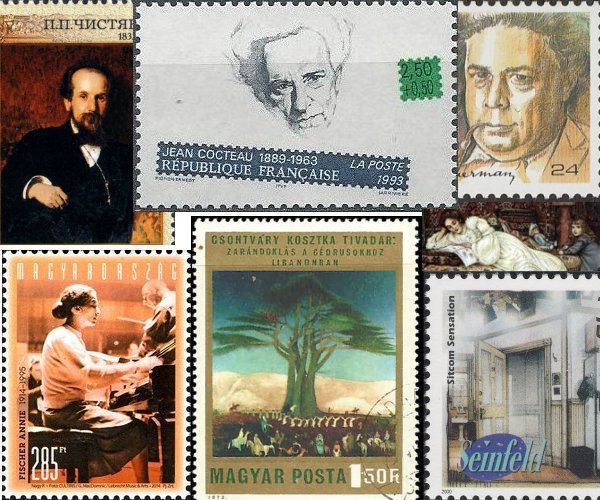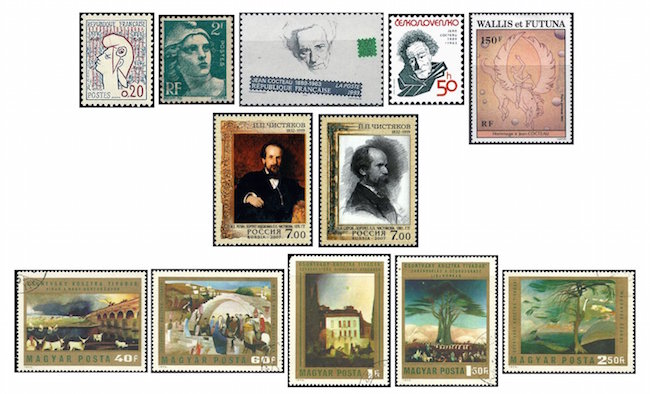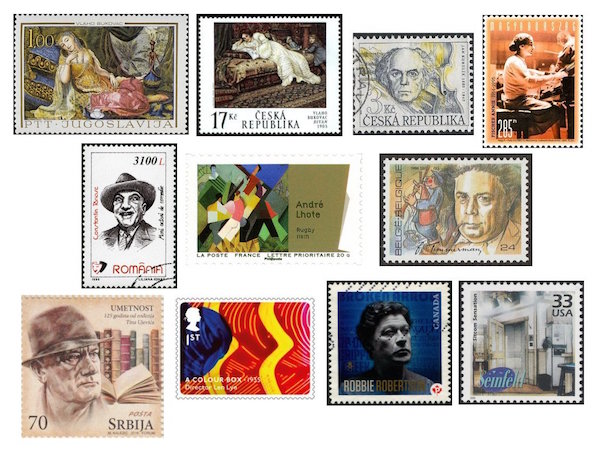The Arts on Stamps of the World — July 5
An Arts Fuse regular feature: the arts on stamps of the world.

By Doug Briscoe
No slight intended to our multitude of artists for this July 5th, but one of them, Jean Cocteau, goes to the head of the class. Otherwise, we have a predominantly Eastern European crowd today: the celebrated Czech violinist Jan Kubelík, the splendid Hungarian pianist Annie Fischer, three painters (and a fourth from France), and a Romanian actor. Add to them a Belgian writer, an experimental filmmaker from New Zealand, and a Canadian popular musician and, with one surprise encore at the end, you have today’s lineup.
Jean Cocteau (5 July 1889 – 11 October 1963) is celebrated as a writer, cineaste, illustrator, and man who knew everybody, but I’ll have you know that he also designed a stamp! The symbolic figure of Marianne has been an icon in France since the revolution, and her image, as interpreted by many artists, has been a fixture on French postage stamps for decades, although perhaps surprisingly only since 1945 (I show an example of the first Marianne design, the work of Pierre Gandon [1899-1990]). Among the artists invited to create new Marianne designs over the years was Cocteau, who made this one in 1961. The other stamps are in tribute to Cocteau, one from France, one from Czechoslovakia, and one, with Cocteau’s lithograph Pegasus (appropriately an air mail stamp), from Wallis and Futuna.
Next we tackle all three of our Eastern European painters in quick succession. Pavel Petrovich Chistyakov (5 July 1832 – 11 November 1919) specialized in historical and genre paintings as well as portraits. He had many distinguished students, the greatest of whom was Ilya Repin (Repin’s 1878 portrait of Chistyakov is seen on the first stamp), but he also taught Valentin Serov (his drawing of Chistyakov is on the second stamp), Vasily Surikov, Viktor Vasnetsov, and Mikhail Vrubel. Oddly, I could find no stamp showing Chistyakov’s own work, so here is a link to his gold medal winner, Patriarch Hermogenes refusing to bless the Poles of 1860.

A bit of a mystic, Tivadar Csontváry Kosztka (July 5, 1853 – June 20, 1919) had a vision when he was 27 informing him that would become the world’s greatest painter. He was a vegetarian, a pacifist, a non-smoker, and a teetotaler, so naturally all the normal people thought he was a crank. He traveled the world and painted huge canvases. Not much recognized during his lifetime, Kosztka was honored with an entire set of stamps in 1973, from which I show five: Storm on the Hortobágy (1903), Mary’s Well in Nazareth (1908), Carriage Ride by Moonlight in Athens (1904), Pilgrimage to the Cedars to Lebanon (1907), and The Lonely Cedar (1907). I link also to his Self-Portrait (c1900).
Croatian painter Vlaho Bukovac (5 July 1855 – 23 April 1922) produced work in many different styles over the course of his working life. The variation can be clearly seen in the two stamps we have for him, although the subjects are very similar. The Yugoslav stamp from 1967 shows The Young Sultana and the Czech stamp (an identical design was issued by Croatia on the same day in 2002) his Divan (1905). Unfortunately I can’t find a date for The Young Sultana. Bukovac was born Biagio Faggioni to an Italian father living near Dubrovnik. Bukovac traveled a great deal, even spending some of his teen years in the United States, and was a frequent visitor to England. His best known painting is actually the heady and intoxicating Une fleur (A Flower) (1887).
July 5 is also the birthday of Jan Kubelík (1880 – 5 December 1940), the father of conductor Rafael Kubelík and a world-class violinist who wrote six concertos for his instrument. With a high-profile career, he recorded with Melba and was painted by Braque.
Annie Fischer (1914 – April 10, 1995) was one of the superb pianists of the twentieth century. She was Jewish and fled her native Hungary for Sweden in 1940, but returned to Budapest after the war. She excelled at Mozart and was one of the few women to record all the Beethoven piano sonatas. Her stamp was issued for her centenary three years ago.
Romanian revue actor Constantin Tănase (July 5, 1880 – August 29, 1945) performed on the stage in his youth but was for years a teacher before returning to the theater in 1917 and founding his own company two years later. He appeared only rarely in films. There is a story, unverified, that he may have been murdered by the Soviets on account of his making fun of Red Army soldiers’ tendency to steal goods such as watches from civilians.
French Cubist André Lhote (5 July 1885 – 24 January 1962) trained as a sculptor in wood from childhood. He gradually turned to painting, moved to Paris in 1906, and had his first exhibition there four years later. He was influential as a writer, lecturer, and teacher. Lhote is represented on a French stamp with his Rugby (1917).

Prolific Belgian writer Felix Timmermans (5 July 1886 – 24 January 1947) was an autodidact who wrote plays, novels, and poetry and also painted from an early age. His religious question remained largely unresolved and finds expression in his historical novels and other work. His most celebrated novel, Pellieter (1916), has been translated into 40 languages. Timmermans was thrice nominated for the Nobel Prize.
There are those who maintain that Augustin Josip “Tin“Ujević (July 1891 – 12 November 1955) was the greatest Croatian poet of the 20th century. As a young man he moved in nationalist circles and was several times imprisoned by the Austro-Hungarian government. A published poet at eighteen, he wrote a candid self-assessment in a pair of essays called “Hateful Me” (1922) and “Examination of Conscience” (1923). Because of his employment as a translator with the Axis puppet state of Croatia, he was disallowed from publishing for several years in post-war Yugoslavia. Ujević was a tireless translator of literature and philosophy from English (Poe, Whitman, Conrad), French (Proust, Gide, Rimbaud), and Italian (Benvenuto Cellini). He also wrote stories, essays, and literary criticism, his total output filling seventeen volumes. A poetry award in his name has been given since 1980.
The New Zealand-born artist Len Lye (5 July 1901 – 15 May 1980), who lived in the United States from 1944 and became a citizen in 1950, worked in experimental film and kinetic sculpture. He left New Zealand for London in 1926 and began making direct film, animation drawn directly onto film stock, and his work A Colour Box (1935) is said to be the first such film ever presented to the public. A still from this four-minute film is seen on the British postage stamp. His films are all very brief, some lasting only a minute. Over the years he tried out a variety of media and techniques in this area. As for kinetic sculpture, which he called “Tangibles”, he saw it as related to film as a kind of “art of motion”.
Multitalented Canadian musician Robbie Robertson (born July 5, 1943) was lead guitarist with the band known as The Band in its earlier incarnation (1968-77), and he wrote most of their songs. Robertson went on to work on film soundtracks with Martin Scorsese and to follow a solo career. He has also performed with other artists (Joni Mitchell, Ringo Starr, Eric Clapton) and has produced a number of albums.
It was on this day in 1989 that TV’s Seinfeld debuted on NBC. It ran for nine seasons.
A graduate of the University of Massachusetts with a B.A. in English, Doug Briscoe worked in Boston classical music radio, at WCRB, WGBH, and WBUR, for about 25 years, beginning in 1977. He has the curious distinction of having succeeded Robert J. Lurtsema twice, first as host of WGBH’s weekday morning classical music program in 1993, then as host of the weekend program when Robert J.’s health failed in 2000. Doug also wrote liner notes for several of the late Gunther Schuller’s GM Recordings releases as well as program notes for the Boston Classical Orchestra. For the past few years he’s been posting a Facebook “blog” of classical music on stamps of the world, which has now been expanded to encompass all the arts for The Arts Fuse.
